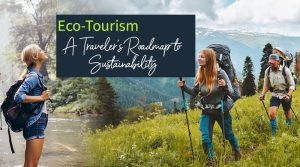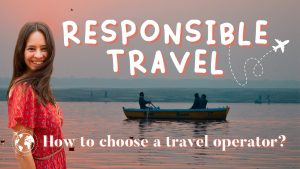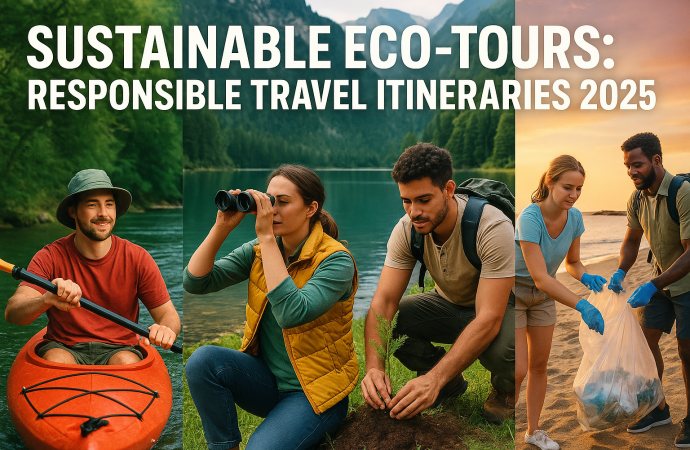Introduction Imagine waking up each morning to the soft songs of native birds. You sip tea on a wooden deck that looks out over a green valley. This is what sustainable eco-tours promise. In the United States in 2025, travelers care more than ever about leaving places exactly as they found them. They want day
Introduction
Imagine waking up each morning to the soft songs of native birds. You sip tea on a wooden deck that looks out over a green valley. This is what sustainable eco-tours promise. In the United States in 2025, travelers care more than ever about leaving places exactly as they found them. They want day trips that respect local cultures and protect fragile ecosystems. With responsible travel plans, you can visit rainforests, deserts, and coastlines without harming them. From choosing a tour operator to picking an eco-friendly sustainable travel style, every choice matters. Each step can help local people and nature. This article will guide you through planning a long term journey that travels lightly, benefits local communities, and fills your heart with wonder.
What Are Sustainable Eco-Tours?

Image by: Yandex.com
Sustainable eco-tours mix hands-on road trips with caring for the environmental impacts. They’re more than just sightseeing. You learn how to protect wildlife, support local guides, and stay in eco-lodges that save energy and cut down on waste. These tours usually keep groups small so plants and animals can go about their lives undisturbed. Everything from how you travel to what you eat aims to lower pollution. When you book a carbon-neutral tour, the company balances out your emissions by planting trees or funding clean energy efficiency projects. This approach makes sure your adventure doesn’t harm the planet.
Eco-tours also teach eco-friendly habits. You’re asked to carry a reusable water bottle, refuse single-use plastics, and respect local customs. Many operators work with community groups, so your spending goes directly to rural families. In 2025, travelers want real experiences. They hope to learn from native cultures, spot rare animals, and leave a positive mark. By choosing sustainable eco-tours, you help protect the very places that inspire you.
Why Choose Responsible Travel Itineraries?

Image by: Yandex.com
Responsible travel and conservation go together. A responsible travel plan is made to lessen harm to nature and help local people. It often includes volunteer options like beach clean-ups or watching local wildlife. You walk on paths built to stop soil from washing away. You visit farms that use earth-friendly farming methods.
This way of traveling builds stronger connections. Instead of rushing between landmarks, you stay longer at small, family-run lodges and eat meals made from fresh, local foods. You see how communities adapt to climate change and take part in workshops on sustainable crafts. These experiences open your eyes and encourage you to bring greener habits home.
When tourist money goes straight to local families, communities become more resilient. Villages use the funds for schools, health clinics, and solar panels. Wildlife reserves get support for anti-poaching patrols. By choosing a responsible travel plan, you turn your personal journey into a positive force for people and the planet.
Top Destinations for Eco-Friendly Travel

Image by: Yandex.com
Below is a table featuring three standout tourist destinations for eco-friendly travel in 2025. Each spot offers unique habitats, top seasons to visit, and highlights that embody green tourism principles.
| Destination | Best Season | Highlight | Why It’s Eco-Friendly |
|---|---|---|---|
| Costa Rica’s Osa Peninsula | December – April | Nighttime rainforest hikes to spot tree frogs | Lodges powered by solar, community-run conservation projects |
| Finland’s Lakeland | June – August | Canoe trips through pristine lakes | Climate-neutral transport, strict waste management |
| Namibia’s Damaraland | May – September | Tracking desert-adapted elephants | Revenue funds anti-poaching, stays in low-impact camps |
Each of these regions prioritizes low-impact travel.You ride electric boats, use biodegradable soaps, and learn about local flora and fauna from expert naturalists. Costa Rica, your national parks, state park fees support reforestation. In Finland, you paddle silently, leaving barely a ripple. In Namibia, you follow tracks without disturbing wildlife.
Tips for Planning Low-Impact Eco-Tours

Image by: Yandex.com
There are some tips for planning low-impact eco-tours:
- Plan your trip carefully so you leave only footprints behind. First, research travel companies that share clear sustainability reports. Look for badges like GSTC (Global Sustainable Tourism Council). These show they follow eco-friendly travel rules.
- Next, pack smart. Choose clothes made from recycled fabrics. Bring a reusable water bottle, cloth snack bags, and biodegradable toiletries. Carry your own travel cutlery set so you don’t need plastic forks or spoons.
- Travel in small groups when you can. A van with a few people means each person’s pollution is lower. If you fly, pick routes with layovers that cut total carbon emissions. Even better, take trains or buses for shorter trips.
- Always respect local culture. Learn a few words in the native language. Ask before you take photos of people. Buy handmade crafts from community markets instead of imported souvenirs. This way, your responsible travel plan leads to real connections and helps the places you visit.
Challenges of Offering Sustainable Eco-Tours
Despite growing demand, eco-tour operators face real hurdles. Checking every supplier for green practices takes time and money. Remote areas often lack reliable transport or accommodations, making planning tricky. Training guides in both language skills and conservation science can be costly. Balancing small group sizes with tour affordability pressures profit margins. Some travelers expect luxury standards that conflict with low-impact goals. To overcome these issues, operators must invest in local partnerships, clear certifications, and flexible, transparent pricing.
Future of Eco-Tourism

Image by: Yandex.com
Eco-tourism evolves with technology and awareness. In 2025 and beyond, we’ll see more virtual reality previews of remote sites. This can reduce unnecessary travel experiences while still educating potential visitors. Blockchain may track carbon credits in real time, making offsets more transparent. Drone surveys can monitor wildlife without invasive patrols.
Community-led cooperatives will gain market share, ensuring that local voices steer tourism development. Policies will favor operators with proven sustainability records. Travel apps or Google Maps will suggest low-impact routes, flag carbon-neutral lodging, and connect you with social enterprises. The next wave of explorers will value purpose over novelty, seeking trips that heal both self and planet.
Conclusion
In Los Angeles in 2025, sustainable eco-tours are more than a trend—they are a necessity. By choosing responsible popular destinations and travel itineraries, you protect ecosystems, support communities, and enjoy deeper, more meaningful adventures. From picking certified lodges to measuring your carbon footprint, every choice counts. As eco-friendly travel industry grows, so does the opportunity to preserve the world’s wonders for future generations. Let your next journey be a force for good, inspiring others to follow in your green footsteps.
















